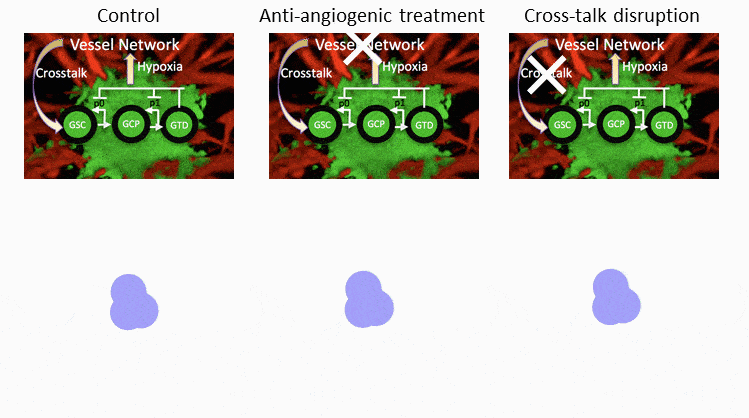
In glioblastoma, the crosstalk between vascular endothelial cells (VECs) and glioma stem cells (GSCs) has been shown to enhance tumor growth. We develop a hybrid continuum-discrete mathematical model and show that the VEC-GSC crosstalk increases both tumor size and GSC fraction by enhancing GSC activity and neovascular development. Unlike anti-angiogenic therapies, which reduce tumor size but may significantly increase tumor invasiveness, partially disrupting the crosstalk by blocking VEC secretion of GSC promoters reduces tumor size but does not increase invasiveness, which supports the targeting of VEC-GSC crosstalk as a promising cancer therapy.
Glioblastoma (GBM), the most aggressive brain tumor in human patients, is highly heterogeneous and extensively vascularized. The glioma stem cell (GSC) hierarchy has been found to play a crucial role in tumor development and therapy resistance. For example, tumors with high GSC population are more aggressive than tumors with low or no GSCs and GSCs are more resistant to radiotherapy and chemotherapy. GSCs have been found to be strongly angiogenic through the secretion of high levels of Vascular Endothelial Cell Growth Factor (VEGF). In addition, vascular endothelial cells (VECs) have been found to secrete factors that stimulate the self-renewal and proliferation of GSCs. This crosstalk between vascular endothelial cells (VECs) and GSCs has been shown to enhance tumor growth. In this work, we develop a hybrid continuum-discrete mathematical model of hierarchically organized, vascularized GBM tumors to study VEC-GSC crosstalk, explore tumor growth under various initial and microenvironmental conditions and investigate the effects of blocking this crosstalk. VEC-GSC crosstalk is modeled via VEGF production by tumor cells and by secretion of soluble factors by VECs that promote GSC self-renewal and proliferation.
Our results show that the VEC-GSC crosstalk increases both tumor size and GSC fraction by enhancing GSC activity and neovascular development, consistent with experiments. VEGF promotes vessel formation, and larger VEGF sources typically increase vessel numbers, which enhances tumor growth and stabilizes the tumor shape. Increasing the initial GSC fraction has a similar effect. Partially disrupting the crosstalk by blocking VEC secretion of GSC promoters reduces tumor size but does not increase invasiveness, which is in contrast to anti-angiogenic therapies, which reduce tumor size but may significantly increase tumor invasiveness. Our multiscale modeling supports the targeting of VEC-GSC crosstalk as a promising approach for cancer therapy.
Keywords: Mathematical Model, Feedback Regulation, Brain Tumors, Cancer Stem Cells, Cancer Therapies

